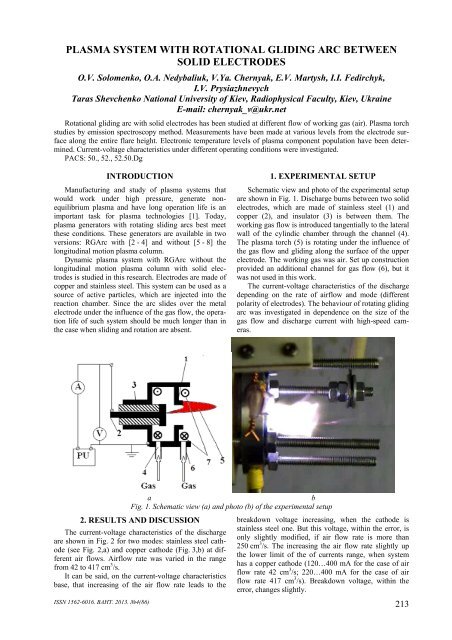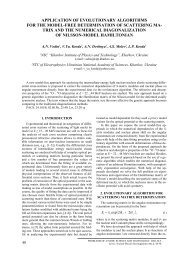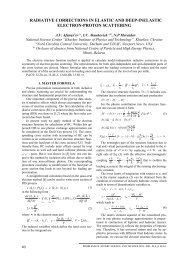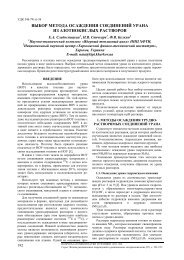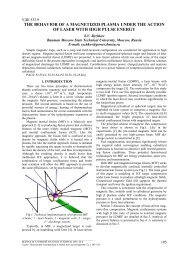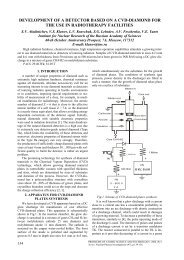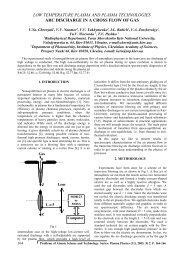plasma system with rotational gliding arc between solid ... - ÐÐÐТ
plasma system with rotational gliding arc between solid ... - ÐÐÐТ
plasma system with rotational gliding arc between solid ... - ÐÐÐТ
You also want an ePaper? Increase the reach of your titles
YUMPU automatically turns print PDFs into web optimized ePapers that Google loves.
PLASMA SYSTEM WITH ROTATIONAL GLIDING ARC BETWEENSOLID ELECTRODESO.V. Solomenko, O.A. Nedybaliuk, V.Ya. Chernyak, E.V. Martysh, I.I. Fedirchyk,I.V. PrysiazhnevychTaras Shevchenko National University of Kiev, Radiophysical Faculty, Kiev, UkraineE-mail: chernyak_v@ukr.netRotational <strong>gliding</strong> <strong>arc</strong> <strong>with</strong> <strong>solid</strong> electrodes has been studied at different flow of working gas (air). Plasma torchstudies by emission spectroscopy method. Measurements have been made at various levels from the electrode surfacealong the entire flare height. Electronic temperature levels of <strong>plasma</strong> component population have been determined.Current-voltage characteristics under different operating conditions were investigated.PACS: 50., 52., 52.50.DgINTRODUCTIONManufacturing and study of <strong>plasma</strong> <strong>system</strong>s thatwould work under high pressure, generate nonequilibrium<strong>plasma</strong> and have long operation life is animportant task for <strong>plasma</strong> technologies [1]. Today,<strong>plasma</strong> generators <strong>with</strong> rotating sliding <strong>arc</strong>s best meetthese conditions. These generators are available in twoversions: RGArc <strong>with</strong> [2 - 4] and <strong>with</strong>out [5 - 8] thelongitudinal motion <strong>plasma</strong> column.Dynamic <strong>plasma</strong> <strong>system</strong> <strong>with</strong> RGArc <strong>with</strong>out thelongitudinal motion <strong>plasma</strong> column <strong>with</strong> <strong>solid</strong> electrodesis studied in this rese<strong>arc</strong>h. Electrodes are made ofcopper and stainless steel. This <strong>system</strong> can be used as asource of active particles, which are injected into thereaction chamber. Since the <strong>arc</strong> slides over the metalelectrode under the influence of the gas flow, the operationlife of such <strong>system</strong> should be much longer than inthe case when sliding and rotation are absent.1. EXPERIMENTAL SETUPSchematic view and photo of the experimental setupare shown in Fig. 1. Discharge burns <strong>between</strong> two <strong>solid</strong>electrodes, which are made of stainless steel (1) andcopper (2), and insulator (3) is <strong>between</strong> them. Theworking gas flow is introduced tangentially to the lateralwall of the cylindic chamber through the channel (4).The <strong>plasma</strong> torch (5) is rotating under the influence ofthe gas flow and <strong>gliding</strong> along the surface of the upperelectrode. The working gas was air. Set up constructionprovided an additional channel for gas flow (6), but itwas not used in this work.The current-voltage characteristics of the dischargedepending on the rate of airflow and mode (differentpolarity of electrodes). The behaviour of rotating <strong>gliding</strong><strong>arc</strong> was investigated in dependence on the size of thegas flow and discharge current <strong>with</strong> high-speed cameras.abFig. 1. Schematic view (a) and photo (b) of the experimental setup2. RESULTS AND DISCUSSIONThe current-voltage characteristics of the dischargeare shown in Fig. 2 for two modes: stainless steel cathode(see Fig. 2,a) and copper cathode (Fig. 3,b) at differentair flows. Airflow rate was varied in the rangefrom 42 to 417 cm 3 /s.It can be said, on the current-voltage characteristicsbase, that increasing of the air flow rate leads to thebreakdown voltage increasing, when the cathode isstainless steel one. But this voltage, <strong>with</strong>in the error, isonly slightly modified, if air flow rate is more than250 cm 3 /s. The increasing the air flow rate slightly upthe lower limit of the of currents range, when <strong>system</strong>has a copper cathode (120…400 mA for the case of airflow rate 42 cm 3 /s; 220…400 mA for the case of airflow rate 417 cm 3 /s). Breakdown voltage, <strong>with</strong>in theerror, changes slightly.ISSN 1562-6016. ВАНТ. 2013. №4(86)213
a)b b)aFig. 2. Current-voltage characteristics of discharge: stainless steel cathode (a), copper cathode (b) at various airflow rates (from 42 cm 3 /s to 417 cm 3 /s)The emission spectroscopy was used for <strong>plasma</strong> diagnostics.Emission spectra were registered by usage ofspectral device – spectrometer S-150-2-3648 USB. Thisspectrometer allows registering the emission spectra inthe wavelength range 200…1000 nm. Temperatures ofexcited electron levels population for various chemicalelements and their distribution along the <strong>plasma</strong> torchwere defined in dependence on the air flow rate valueand discharge current. This method is described in detailsin [9].Typical emission spectra of <strong>plasma</strong> in <strong>rotational</strong><strong>gliding</strong> <strong>arc</strong> discharge are shown in Fig. 3: stainless steelcathode (see Fig. 3,a); copper cathode (see Fig. 3,b).a a)b b)Fig. 3. Typical emission spectra of <strong>plasma</strong> in <strong>rotational</strong> <strong>gliding</strong> <strong>arc</strong> discharge <strong>with</strong> <strong>solid</strong> electrodes for stainlesssteel (a) and copper (b) cathode. G = 167 cm 3 /s; h = 0 mm; I = 340 mA; U = 0,8 kV214Spectra in both cases are mixtures, they containatomic lines, electrode materials Cr, Fe, and Cu multiplets,oxygen atoms O multiplets, and NO molecularbands. The temperatures of excited electron levels population(T e * ) <strong>plasma</strong> components such as Cr and O weredetermined from these spectra. Determination of temperaturesof excited electron levels population (T e * ) foroxygen atoms was carried by the Boltzmann diagrammethod using three most intense multiplets (777.2 nm,844 nm, 926 nm) and data from [3]. T * e of Cr atoms hasbeen determined by the ratio of the intensity of two intensemultiplets (357.9 nm and 425.4 nm) by usingcomparison of calculated and experimental spectra. Determinationof other components temperatures has beensignificantly more complex. It was caused by overlappingof their spectra.The <strong>plasma</strong> discharge was diagnosed at differentdischarge currents and along the <strong>plasma</strong> torch height(h). The range of air flow rate is 167…417 cm 3 /s. Thetemperature (T e * ) dependences on the current level werespecified for Cr and O atoms at different air flow ratesand stainless steel cathode. They are shown at Fig. 4.The error of T e * definition is near 500 K, so we can saythat the components temperature depends weakly fromcurrent.ISSN 1562-6016. ВАНТ. 2013. №4(86)
aa) b)bFig. 4. The temperature (T * e) distribution for oxygen and chrome atoms under different air flows for oxygen (а)and chrome atoms (b) as a function of discharge currentThe temperature (T e * ) of Cr atoms increases <strong>with</strong> theair flow in the range of air flow rate 167…333 cm 3 /s.The temperature (T e * ) of O atoms, <strong>with</strong>in the error, doesnot change. It may be noted that the temperature of excitedelectron levels population at Cr atoms in1.5…2 times higher than same temperature of oxygenatoms. This can be explained by the peculiarities ofthese chemical elements excitation.Axial temperature (T e * ) distribution for oxygen andchrome atoms under different air flows(167…417 cm 3 /s) and stainless steel cathode is presentedat Fig. 5.a a) b b)Fig. 5. The temperature (T * e) distribution for oxygen (a) and chrome (b) atoms under different air flows alongthe <strong>plasma</strong> torch height. Discharge current - 300 мАThe relationships mentioned above, show that temperature(T * e ) of oxygen atoms is increased <strong>with</strong> heightof the <strong>plasma</strong> torch for low air flow rate (167 cm 3 /s).Such dependence wasn’t observed for larger airflows.An essential increasing in T *e was observed at themaximum flow (417 cm 3 /s) for Cr atoms along <strong>plasma</strong>torch. Such trend wasn’t observed for smaller flows.The maximum <strong>plasma</strong> torch height was lower andfixation of emission spectra <strong>plasma</strong> was more difficultin case of copper cathode. The temperature T * e (O) is3500 ± 500 K, <strong>with</strong>in the error, does not change <strong>with</strong>height of the <strong>plasma</strong> torch and the air flow rate (167 and417 cm 3 /s). T * e (Cr) is 7000 ± 500 K in a range ofheights (h = 0…5 mm) at low air flow (167 cm 3 /s). Thetemperature T * e (Cr) = 9000 ± 500 K at the beginning ofthe torch (h = 0mm) and 8000 ± 500 K on heighth = 5 mm at the maximum airflow (417 cm 3 /s).CONCLUSIONSElements of both electrodes (Cu and Fe, Cr) presentin the torch <strong>plasma</strong>. Also the spectra in small amountsare multiplets of oxygen atoms and bands of NO molecules.When the cathode is stainless steel, temperature Crand O weakly changed from current. However, T e * ofthese components has strong dependence on air flow.Observed strong increase T e * for O in the case ofsmall air flow (167 cm 3 /s) height the <strong>plasma</strong> torch.Along <strong>with</strong> being temperature throughout the <strong>plasma</strong>torch height <strong>with</strong>in the error limits does not change athigh airflow.Axial distribution of T e * (Cr) for small air flow doesnot change <strong>with</strong>in the error limits, but at high air flow(417 cm 3 /s) it was detected change of T e * (Cr) in heightthe <strong>plasma</strong> torch.ISSN 1562-6016. ВАНТ. 2013. №4(86)215
ACKNOWLEDGEMENTSThis work was partially supported by the TarasShevchenko National University of Kyiv.REFERENCES1. A. Fridman, A. Chirokov and A. Gutsol. Nonthermalatmospheric pressure discharges // J. Phys.D: Appl. Phys. (38). 2005, R1–R242. C.S. Kalra, A.F. Gutsol, A.A. Fridman. Gliding <strong>arc</strong>discharges as a source of intermediate <strong>plasma</strong> formethane partial oxidation // IEEE Trans. Plasma Sci.(33). 2005, № 1, p. 32-41.3. A. Czernichowski. Conversion of waste Glycerolinto Synthesis Gas // 19 th Int. Symp. on PlasmaChem. (ISPC-19), Bochum, Germany, July 26-31.2009, 4 p.4. J.M. Cormier, I. Rusu. Syngas production via methanesteam reforming <strong>with</strong> oxygen: <strong>plasma</strong> reactorsversus chemical reactors // J. Phys. D: Appl. Phys.(34). 2001, p. 2798-2803.5. J.M. Cormier, I. Rusu, A. Khacef. On the use of amagnetic blow out glid<strong>arc</strong> reactor for the syngasproduction by stem reforming // 16 th Internationalsymposium on <strong>plasma</strong> chemistry, Taormina. 2003.6. V. Chernyak. Gas discharge <strong>plasma</strong> in dynamics<strong>system</strong> as a noneqilibrium <strong>plasma</strong> sources // Proc.3 rd Czech-Russian Seminar on Electrophysical andThermophysical Processes in Low-temperaturePlasma, Brno, November 16-19. 1999, p. 94-99.7. O.A. Nedybaliuk, V.Ya. Chernyak, E.V. Martysh,T.E. Lisitchenko. System <strong>with</strong> <strong>plasma</strong> injector ofhydrocarbons <strong>with</strong> high viscosity // Proc. of the VIIIInternational Conference “Electronics and AppliedPhysics”, October 24-27, 2012, Kyiv, Ukraine.2012, p. 148-149.8. O.A. Nedybaliuk, V.Ya. Chernyak, E.V. Martysh,T.E. Lisitchenko, O.Yu. Vergun, S.G. Orlovska.Plasma assisted combustion of paraffin mixture //Problems of Atomic Science and Technology. Series«Plasma Physics» (19). 2013, № 1, p. 219-221.9. I.V. Prisyazhnevich, V.Ya. Chernyak, P.A. Korotkov,V.V. Naumov, I.L. Babich, Y.I. Slyusarenko,V.V. Yukhymenko, V.A. Zrazhevskiy. Defenition ofthe excitated electron levels ocupation in <strong>plasma</strong>from the emition spectum of the transversal electric<strong>arc</strong> // Bulletin of the University of Kiev. Series«Physics & Mathematics» (1). 2005, p. 289-298.Article received 16.05.2013.ПЛАЗМЕННАЯ СИСТЕМА С ВРАЩАТЕЛЬНОЙ СКОЛЬЗЯЩЕЙ ДУГОЙ С ТВЕРДЫМИЭЛЕКТРОДАМИЕ.В. Соломенко, О.А. Недыбалюк, В.Я. Черняк, Е.В. Мартыш, И.И. Федирчик, И.В. ПрисяжневичИсследовалась вращательная скользящая дуга с твердыми электродами при различных потоках рабочегогаза (воздуха). Проводились исследования плазменного факела методом эмиссионной спектроскопии. Измеренияпроводились на разных уровнях от поверхности электрода вдоль всей высоты факела. Определенытемпературы заселения возбужденных электронных уровней компонент плазмы. Исследованы вольтамперныехарактеристики при различных режимах работы.ПЛАЗМОВА СИСТЕМА З ОБЕРТОВОЮ КОВЗНОЮ ДУГОЮ З ТВЕРДИМИ ЕЛЕКТРОДАМИО.В. Соломенко, О.А. Недибалюк, В.Я. Черняк, Є.В. Мартиш, І.І. Федірчик, І.В. ПрисяжневичДосліджувалась обертова ковзна дуга з твердими електродами за різних потоків робочого газу (повітря).Проводилися дослідження плазмового факелa методом емісійної спектроскопії. Виміри проводились на різнихрівнях від поверхні електроду вздовж усієї висоти факелa. Визначені температури заселення збудженихелектронних рівнів компонент плазми. Досліджені вольт-амперні характеристики при різних режимах роботи.216ISSN 1562-6016. ВАНТ. 2013. №4(86)


